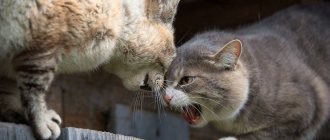Aggressive reactions of domestic animals are closely related to the behavior of wildlife. Attacking actions are a natural component of the hunting process, play activity, as well as conflicts that arise when interacting with relatives.
Being an independent creature that hunts alone, the cat avoids physical confrontation, which it perceives as a threat to life; an open fight can lead to injury, loss of the ability to hunt and, as a result, death. To relieve tension and avoid conflict, the animal uses a whole communication system: sound signals, body position, facial expression and scent marks. Despite this, under certain circumstances, clashes between animals are inevitable - if physical fighting is the only way out of the situation, or the aggressor is confident of a successful outcome for him.
There are several reasons for aggressive behavior that occurs between cats, both indoors and outdoors. In both cases, animals are trying to designate their habitat and protect the areas that are most important to them from the invasion of strangers. Strong representatives of the cat family actively seek opportunities to expand the boundaries of their territory; weaker individuals become easy targets for them. If an animal is unable to protect its habitat from its relatives, it turns into a homebody. The cat's space becomes so limited that a normal walk outside the house becomes dangerous.
Strange cats may use a cat flap, open door or window to gain entry into someone else's home. This will provoke aggression both from the pet in the room and from the uninvited guest. There are times when the “master” does not react to the invasion of a stranger, but this is more due to fear than from a positive attitude towards an unexpected meeting. The unexpected appearance of a foreign animal in the house can also provoke a conflict between pets living together - the anxiety caused by the sudden event will lead to an escalation of tensions that had previously remained at an acceptable level. A similar effect occurs if a large number of relatives live in the neighborhood of the cat; their presence suppresses the animal.
Confrontation can arise between incompatible individuals living in the same house. In such a situation, cats prefer to stay in their chosen room and are reluctant to leave it; The presence of another, stronger relative with whom he has to share a home can force a pet to “sit within four walls.” If contact cannot be avoided, the animal displays open aggression. The speed of response from the other participant depends on the genetic characteristics of the animal, gender and experience.
Owners who keep females in the house during their breeding season may also experience bouts of aggression in their charges when they protect their cubs. Such an environment is a source of tension, especially when animals capable of bearing children and those deprived of this opportunity (sterilized and neutered) live together.
How to recognize conflict between pets? Will it lead to a fight?
Cats adapt well and share space with other pets even in the absence of any connection with them. Animals living in the same household may form cliques or splinter groups. In them, relatives coexist side by side, but each remains “to his own opinion” and tries to avoid contact if possible. This does not mean that there will not be cases of open confrontation between members of isolated factions over access to certain resources at certain times. This suggests that instead of physical “fighting”, cats will prefer “psychological pressure” as a more effective tactic.
Within the cat group there are individuals who seek to suppress their relatives, and they need a victim. It becomes a pet, which reacts strongly and with pronounced fear to the threatening actions and posture of its cohabitants. The more afraid an animal is, the more willingly its relatives are involved in this “game”. Some representatives of the cat family do not stop until they kick the victim out of the house. Cats that are being bullied begin to get sick due to constant emotional stress. Therefore, it is very important to notice “quiet” cat conflicts in time. Signs that your pet has turned into a victim include staring in its direction, trying to take its place to sleep, obstructing attempts to climb onto your lap, jumping on it while resting, and blocking passages (for example, an aggressor animal may block the flap window in the door or the path to the tray with your body). Psychological bullying is not easy to spot. A tyrannical cat, lying between its fellow cat and some place attractive to cats, does not look aggressive. From the outside it may seem that the animal is simply choosing a location that is convenient for itself.
How to relieve aggression in a cat
Living with an aggressive cat is stressful for all family members, including humans. In order to stop hostility from one of your cats, you should start by closely monitoring its daily activities to identify signs of hidden aggression. A cat exhibiting aggressive or dominant behavior does not necessarily mean that it is an aggressive or dominant animal.
“Aggression is not a diagnosis or a personality trait of a cat, but a consequence of an emotional state,” explains International Cat Care. An aggressive cat—or any other cat, for that matter—should not be physically punished because this can lead to more fear and more aggression. Instead, you should focus your efforts on calming an aggressive cat.
To do this, rough play and fighting should be discouraged, as they can promote aggression. You can feed the cats in different places and install more litter boxes to give each cat the feeling that it has its own territory. You can also double the number of cat toys and beds.
Pets sometimes don't want to share their owners. If a cat hisses or growls when another cat clings to its owner, it is in this way trying to secure its dominant position. By safely removing the aggressor cat from the scene, the owner will let the cats know that such behavior is unacceptable. But you should never interfere in a fight between cats to avoid injury. It is worth redirecting their attention by making a loud noise or throwing a toy in the opposite direction.
Positive reinforcement for good behavior must not be forgotten, as it may take weeks or even months to bring about change. If a cat's aggression towards another cat is considered excessive, it is necessary to speak with a veterinarian to rule out health problems.
Cats may not be the best of friends, but by patiently getting them to show at least basic courtesy towards each other, you can create a happy and harmonious home for all its inhabitants.
How to distinguish a fight in a game from a real conflict?
Many cats that have a close bond enjoy playing together. They fight, rush around the apartment, roll around in a ball and hit each other with their paws. Play wrestling often takes place silently with breaks during which the participants change positions. Such fights do not bring pain, because... the animals retract their claws and strike carefully. At this stage there is no need to separate the pets. In some cases the struggle may intensify; Hissing and squealing indicate that the animal’s partner’s actions are beginning to cause discomfort. After joint activity, the cats quickly return to their normal state, and there is no tension in further relationships between the participants in the play fight.
More Causes of Seizures Between Cats
Animals don't do anything without a reason, and cats are no exception. If your feline friend suddenly turns into a hissing, scratching, snarling broiler, there is a reason for the behavior change.
Aggression is defined as the intent to intimidate or dominate and is a common behavior problem in cats. Unfortunately, an aggressive cat runs the risk of being abandoned at a shelter or abandoned by a frustrated owner.
Of course, it can be confusing when a cat suddenly enrages the people who love him. However, there is always a reason and task - to find out what is bothering the cat . Read on to find out why a normally docile cat can suddenly become aggressive and what you can do to help an angry kitten.
Fear/stress
Although cats tend to be loners, they are also social and capable of forming close bonds with the people they love. However, a cat can become aggressive if it feels threatened, instinctively lashing out to defend itself. For rescued cats, what triggers an aggressive response may be related to a bad experience, such as a fight in the street or adjusting to shelter life. You may not fully understand what causes fear or stress. Your cat may also react to other pets. or even an atmosphere in which people do not get along and fight.
Some of the most common causes of fear or stress in a cat's life include new pets in the house, too many pets in the house, sudden movements, sneaking up on them, loud noises, being abused or unfairly punished, getting hit by the cat. carrying, riding in a vehicle, lack of resources (food, water, toys, scratching post), change in routine or lack thereof.
Pain
Any time a kind and affectionate kitten shows aggression, it's time to visit the veterinarian. Cats are persistent and try to hide pain or illness. A cat may become aggressive to protect an injury or avoid touching a sensitive area. .
Common causes of pain include dental disease, abdominal pain, arthritis, soft tissue injury, or infection. Sudden aggression can also be caused by neurological problems, decreased cognitive abilities and loss of smell, hearing or vision.
Aggression caused by stroke
This is the type of confusing aggression that occurs when you are calmly petting your cat and she suddenly turns towards you, grabbing your hand with her front claws, trying to tear your skin with her back claws and teeth.
This can happen if your cat becomes overstimulated and the pleasant sensation of being petted turns into irritation. It may seem like it came out of nowhere for no reason, but your cat was actually giving you signals that she wants to end her petting session, such as rear ears, dilated pupils, stiffening of her body, growling, and wagging her tail. When you don't notice the signals and continue to pet, attacking is the cat's last resort to stop you. .
Territorial issues
Cats are not afraid to use aggression to defend their territory. If you look out the window and see another cat coming outside, this can cause aggression. Other possible triggers are adding a new cat or dog to the home, an unknown person in the house, or moving house. Sometimes a cat becomes territorial when you pay attention to another pet in the house, and suddenly attacks you or the other pet.
Redirected frustration/aggression
Redirected aggression is one of the most common and unpredictable causes of sudden hostility in cats. This is when the kitten becomes hyperexcited, irritable, or stressed due to an unavailable stimulus.
These are just some of the reasons why a happy kitten may suddenly become aggressive. The first thing to do is schedule a medical check-up with your veterinarian to ensure there is no medical reason for the aggressive behavior. If nothing is found, the next step is to talk to an animal behaviorist who can help you understand your kitten's aggression... or start with the tips we give you below.
How to stop aggressive behavior of pets towards each other?
The aggressive state of a cat can be controlled. To do this, you need to determine what makes your pet behave this way and eliminate the cause. If the source of negative behavior lies in tension arising from the incompatibility of animals or their constant competition, an environment must be created that eliminates the need for conflict. In some cases, relocating one of the cats becomes the only way out of the current situation. However, there is no need to give up prematurely in trying to reach an amicable agreement between furry cohabitants.
There is no quick fix for aggression. The best solution would be to contact a specialist. Following the main advice will also help to correct behavior: all cat resources (places for feeding and resting, water bowls, trays, sleeping beds, toys, scratching posts and areas for privacy) should correspond to the formula “one per cat plus an additional one.” They should be placed in different locations so that each pet has access to resources and feels that they are provided with everything they need. If you have accurately determined the formation of a separate group in an animal community, for example, a “married” couple, then in a limited space it will be enough to adhere to the formula “one resource per group plus one additional one.”
Part of the daily dry ration can be distributed between so-called permanent feeding stations. This will give the animals a feeling of plenty of food and allow them to eat when it suits them. When doing the same with wet food, you should reduce portions and serve them more often to avoid competition at set meal times. Bowls should be placed far apart from each other so that cats do not have to look around, looking for a potential rival. Water is an equally important resource for an animal, so tanks must be placed in different locations away from food, providing pets with quick access to them.
It wouldn’t hurt to provide cats going outside with a “home toilet.” If the victim is bullied in the yard, he will still have the opportunity to visit the relatively safe litter box indoors. The presence of several cat entrances/exits (special shutter windows, doors, windows) will allow even the most timid cat to move freely, avoiding collisions with an aggressor blocking the passages.
Scratching posts are recommended to be installed near entrances, sleeping areas and feeding areas to provide the necessary surface in areas of potential competition: cats sharpen their claws when surrounded by cats to inform them of their territorial rights. Often representatives of the cat family prefer to observe what is happening from an elevated position; this position gives them a feeling of security. At home, you need to take care of the availability of such places. Organizing a personal space – a safe place for privacy and relaxation – will help ensure comfortable living for the animal. An important factor for creating a favorable atmosphere in a cat family is the availability of the required number of warm sleeping places.
Why is a cat acting aggressively?
Aggression is primarily aimed at asserting dominance, explains Sharon L. Crowell-Davis, DVM, in her article for VetFolio. It can take more hidden forms compared to overt aggression. In fact, precisely because cats do this very quietly, you may not even realize that one of the pets is behaving badly.
“Some leader cats are aggressors, meaning they regularly display significant dominance and aggression towards other cats, even when the latter are clearly signaling submission and trying to avoid interaction,” Dr. Crowell-Davis writes. This type of aggression usually occurs in socially stable families that do not experience stress from external factors. In this case, one of the cats wants to assert its dominant position in relation to such important aspects of a cat's life as food, water, litter box, toys and bedding.
In other words, some cats just want to be the boss. This desire may increase with age, says the ASPCA. If your aging cat is experiencing increased aggression or other behavioral changes, you should consult your veterinarian.
My cats suddenly started fighting. What should I do?
If cat aggression results in a fight, the best solution is to separate the animals and place them in different rooms for 1-2 days until they calm down. Repeating active hostilities at the next encounter will require separating the pets for a longer period. In this situation, cats should be perceived as strangers seeing each other for the first time.
Sometimes manifestations of aggression happen at the most inopportune time, when a person is not ready for sudden conflicts. For example, a group of animals may react negatively to the return of a cat that has undergone surgery at the veterinary clinic.
Communication in the cat community is carried out primarily through smell; With their help, animals separate their own from strangers. From the clinic, the cat brings with it a mixture of unpleasant and even threatening “odors.” This misleads the members of her “group”, who are unable to recognize the cat as a companion. To avoid hostility in the cat family, an animal that has been to the veterinarian should be isolated in a separate room for at least 12 hours (or overnight). This time should be enough for the pet to lick the fur and “return its native scent.” By stroking and showing your love in every possible way, you can help the cat stabilize its emotional state, but it is important to be careful when handling the operated animal. It would be a good idea to get care instructions from your veterinarian.
Cats fight, although they used to be friends. What to do?
Sudden enmity between cats that previously lived peacefully is one of the most common reasons for seeking help from animal psychologists.
The reason for the enmity is fear, which is associated with the other cat. Here are two illustrative examples: 1) An old cat was sleeping on the nightstand, a young cat was sitting next to her and washing herself. The hostess came and turned on the TV. Somehow it turned out that the TV was set to maximum volume and it literally roared. The old cat jumped in place and the first thing she saw was a young cat. She, frightened by both the sound and the sudden movements of the old cat, twisted and hissed... A split second later, the older cat attacked the younger one. When the owner managed to separate the cats by pouring water from a jug on them, the cats scattered to different rooms. From that moment on, the older cat began to watch and mercilessly beat the younger one. In this case, the fear of loud noise became associated with the presence of the second cat.
2) The owners decided to keep the kitten from their purebred and very beautiful cat. The cat was a little timid, but the cat - her son - grew up, on the contrary, cheerful, perky and brave. A few months after giving birth, the cat was sterilized. She was very nervous after the operation and took a long time to recover at home. Gradually, all the experiences were forgotten, but they reminded me of themselves 1.5 years later, when the cat was taken to the veterinary clinic to be neutered. When he was brought home, he was lethargic and inactive. The cat came up to smell him and then went into another room. Outwardly, she seemed calm. When the cat came to his senses, he tried to approach the cat. She immediately assumed a threatening pose and hissed. He grew up in this house and was used to treating his mother cat quite familiarly, so he did not react to the threat. Then she attacked him with a heartbreaking scream (as the frightened hostess said). For the next few days, the cat chased the cat and tried to attack him as soon as she saw him. He no longer tried to approach her, did not defend himself, only tried to hide. Here the cat smelled the medicine from the cat and transferred negative associations with the experience of the surgery to him.
In most such cases, the problem of sudden aggression between cats can be dealt with within 2 weeks. So that you can do this yourself, I will tell you about a step-by-step behavior correction scheme. But before we get started, let me remind you:
1) I tell you simple techniques that are accessible to everyone. Most likely they will help you solve the problem. But, also, they may not be enough if the problem is very large, or it manifests itself in combination with other difficulties in the cat’s behavior. In this case, it is better for you to contact an animal behaviorist for individual recommendations.
2) when you undertake to follow the recommendations, do not skip steps, do not change their sequence, and do not violate the time frame, as otherwise you risk aggravating the problem rather than solving it.
We reconcile cats step by step:
Stage 1
Aggression in cats is largely related to brain physiology, namely endorphin synthesis. If a cat’s brain produces “pleasure hormones” in normal quantities, it can more easily cope with any difficult situations and does not have to be scared and defend itself from an imaginary threat. Correction of “sudden enmity” begins with maintaining endorphin synthesis with the help of special drugs. (!!!The drugs described here are sold without a prescription, without contraindications, however, if the cat is not healthy, is allergic, or for some other reason you have doubts, be sure to consult a veterinarian!!!) Veterinary pharmacies sell, for example, Serene Um, Calmex, Good as Gold, Sanal Relax and others. The main thing you should know when looking for a medicinal product: it should contain B vitamins and L-tryptophan (or better yet, take drops rather than tablets: drops are easier to add to your cat’s food).
Drugs with this composition do not calm animals, do not make them slow or drowsy. These are not “heavy” antidepressants. Preparations with tryptophan and B vitamins strengthen the nervous system, similar to those vitamins and supplements that are prescribed to schoolchildren and students during exam periods. About 3 days after starting to take the drug, the cat becomes more cheerful, lively, as if younger, she looks happier. It just becomes easier for her to cope with stress. But don't be under the illusion that this is enough to bring peace to the cats. This is only support in behavior correction, and not the correction itself.











